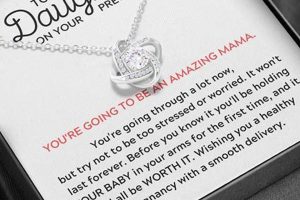The practice of adorning infants with small, decorative jewelry items designed for the ear is a tradition observed across numerous cultures. These adornments are typically small and lightweight, intended for pierced ears and selected with considerations for safety and comfort of the infant.
The placement of these small adornments can hold cultural significance, serving as a marker of identity, gender, or familial status. The act is often a cherished tradition, passed down through generations, with potential associations to aesthetic preferences, perceived beauty, and cultural heritage.
Subsequent sections will delve into specific considerations regarding the selection, care, and potential risks associated with piercing an infant’s ears and introducing these jewelry items.
Guidance on Infant Ear Adornment
The following points offer instruction regarding the practice of placing decorative jewelry in an infant’s pierced ears. Careful consideration should be given to each of these recommendations.
Tip 1: Material Selection: Opt for hypoallergenic materials, such as surgical stainless steel, 14k gold, or titanium, to minimize the risk of allergic reactions or skin irritation. Consider the purity of the metal to avoid nickel content, a common allergen.
Tip 2: Size and Design: Select small, lightweight designs that will not pose a choking hazard or cause discomfort. Avoid dangling styles or those with sharp edges that could snag on clothing or bedding.
Tip 3: Closure Type: Prioritize screw-back closures or those that are securely fastened to prevent accidental removal or loss. Examine the closure mechanism regularly to ensure it remains secure.
Tip 4: Professional Piercing: Engage a reputable professional piercer experienced in performing infant ear piercings. Ensure the piercer adheres to strict hygiene protocols and uses sterile equipment.
Tip 5: Aftercare Regimen: Adhere meticulously to the aftercare instructions provided by the piercer. This typically involves cleaning the pierced area with a saline solution several times a day.
Tip 6: Monitoring for Infection: Vigilantly observe the pierced area for signs of infection, such as redness, swelling, pus, or excessive tenderness. Seek medical attention promptly if any of these symptoms are present.
Tip 7: Regular Cleaning: Clean the adornments regularly with a mild soap and water solution to remove any accumulated dirt or debris. Ensure the jewelry is completely dry before reinserting.
Adherence to these guidelines supports the safety and well-being of the infant. Prioritize meticulous care to minimize potential complications.
The subsequent section will explore potential risks associated with infant ear piercing and offer mitigating strategies.
1. Hypoallergenic Material
The selection of appropriate materials is paramount when considering adornments for infants, particularly earrings. Hypoallergenic materials mitigate the risk of adverse reactions in the sensitive skin surrounding a new piercing.
- Minimizing Allergic Reactions
Hypoallergenic materials, by definition, possess a reduced propensity to cause allergic reactions. This is crucial because infants’ immune systems are still developing, making them more susceptible to sensitization to certain metals. Nickel, a common component in less expensive jewelry, is a frequent allergen. Utilizing hypoallergenic alternatives significantly lowers the likelihood of contact dermatitis or other allergic responses.
- Suitable Material Examples
Several materials are commonly recognized as hypoallergenic and suitable for infant ear adornments. Surgical stainless steel, known for its corrosion resistance and low nickel content, is a popular choice. Titanium, another biocompatible metal, offers similar benefits. Furthermore, karat gold (14k or higher) is often used, as the higher gold content reduces the presence of allergenic metals. Platinum is another option, although it may be a more expensive selection.
- Material Purity and Composition
Even within hypoallergenic categories, variations in material purity and composition exist. For example, while 14k gold is generally considered hypoallergenic, it still contains other metals that could potentially trigger a reaction in highly sensitive individuals. Always verify the specific alloy composition and opt for reputable manufacturers who provide detailed information about their materials.
- Long-Term Wear Considerations
The benefits of hypoallergenic materials extend beyond the initial piercing phase. Prolonged exposure to allergenic metals can lead to chronic skin irritation and sensitivity over time. Using hypoallergenic earrings from the outset reduces the risk of developing these long-term issues and promotes healthy skin around the piercing site.
Therefore, the implementation of hypoallergenic materials in infant ear adornments is not merely a preference but a critical safeguard to ensure the infant’s health and comfort. This choice has ramifications for both immediate and long-term well-being.
2. Secure Closure
The integrity of the closure mechanism in infant ear adornments is of paramount importance. A secure closure is not merely a functional aspect but a critical safety feature, mitigating potential hazards associated with small objects and vulnerable infants.
- Prevention of Accidental Dislodgement and Ingestion
Infants possess a natural tendency to explore their environment orally. A poorly secured earring closure can easily detach, presenting a significant choking hazard. The small size of earring components increases the risk of complete airway obstruction, making a robust closure essential for preventing accidental ingestion and its potentially severe consequences.
- Minimizing Skin Irritation and Infection
A loose earring can rub against the delicate skin of an infant, leading to irritation and potential abrasions. These breaks in the skin barrier increase the susceptibility to bacterial infection at the piercing site. A secure closure keeps the earring in place, minimizing friction and the associated risk of infection.
- Types of Secure Closure Mechanisms
Several closure types offer varying degrees of security. Screw-back closures, where a threaded post is secured with a screw-on backing, are generally considered among the most secure. Flat-back or push-back closures, while common, require careful examination to ensure a snug fit. The specific closure mechanism should be evaluated based on its reliability and resistance to accidental opening.
- Regular Inspection and Maintenance
Even the most secure closure can loosen over time due to wear and tear. Regular inspection of the closure mechanism is crucial. Parents or caregivers should periodically check the tightness and integrity of the closure to ensure it remains functional. Any signs of damage or loosening should prompt immediate replacement of the earring.
In conclusion, the selection of infant ear adornments with a secure closure mechanism is a fundamental safety precaution. A proactive approach to closure type selection, coupled with diligent inspection and maintenance, significantly reduces the risk of harm to the infant, reinforcing the importance of this seemingly small detail.
3. Appropriate Size
The correlation between size and safety in infant ear adornments is direct and consequential. Choosing an appropriate size is not merely a matter of aesthetics; it is a critical factor in preventing injury and ensuring the well-being of the infant. An excessively large earring, for instance, increases the risk of entanglement with clothing or bedding, potentially leading to skin irritation, tearing of the earlobe, or even strangulation. Conversely, an earring that is too small may pose a choking hazard if it becomes dislodged. Therefore, selecting the correct size is a non-negotiable aspect of infant ear adornment.
Practical application of this principle involves careful measurement and consideration of the infant’s ear size and shape. Earrings specifically designed for infants typically feature smaller dimensions and lightweight construction to minimize strain on the delicate earlobe. It is imperative to avoid adult-sized earrings or those with dangling components that could easily be grasped and pulled. Furthermore, parents and caregivers should regularly assess the fit of the earrings, ensuring they remain comfortable and secure without causing pressure or irritation. Real-life examples abound where oversized earrings have resulted in accidental injuries to infants, underscoring the importance of adhering to size guidelines established by pediatricians and experienced piercers.
In summary, the “Appropriate Size” component of infant ear adornments is inextricably linked to safety and comfort. The challenges lie in consistently prioritizing safety over aesthetic preferences and maintaining vigilance in monitoring the fit and condition of the earrings. A thorough understanding of these size considerations is essential for all parents and caregivers who choose to adorn their infants with ear jewelry, contributing to a safer and more comfortable experience. This understanding directly links to the broader theme of prioritizing infant safety and responsible parenting practices.
4. Professional Piercing
The practice of piercing an infant’s ears necessitates strict adherence to safety protocols and hygiene standards. Engaging a qualified professional piercer is paramount in mitigating potential risks associated with this procedure.
- Sterile Environment and Equipment
Professional piercers utilize sterile environments and equipment, minimizing the risk of infection. Autoclaves are employed to sterilize instruments, effectively eliminating bacteria and viruses. The use of single-use needles further reduces the potential for cross-contamination, safeguarding the infant’s health. Real-world examples highlight instances where non-sterile piercing practices have resulted in severe infections, underscoring the importance of this facet.
- Anatomical Knowledge and Precision
Professional piercers possess comprehensive knowledge of ear anatomy, enabling precise placement of the piercing. Accurate placement reduces the risk of nerve damage, cartilage distortion, and uneven healing. Improper placement can lead to discomfort, difficulty wearing earrings, and cosmetic concerns later in life. Professional expertise minimizes these potential complications, ensuring a more favorable outcome.
- Pain Management Techniques
While infant ear piercing is generally brief, professional piercers are equipped to employ pain management techniques to minimize discomfort. This may involve topical anesthetics or distraction methods. These techniques, while not eliminating pain entirely, can reduce anxiety and discomfort for the infant during the procedure. Ethical considerations necessitate the use of appropriate pain management strategies whenever possible.
- Aftercare Instruction and Support
Professional piercers provide detailed aftercare instructions, ensuring proper healing and minimizing the risk of infection. These instructions typically include cleaning protocols, warning signs of infection, and recommendations for appropriate earring materials. Ongoing support is often available to address any concerns or complications that may arise during the healing process. This support system is crucial in achieving a successful outcome and promoting the infant’s well-being.
The engagement of a professional piercer for infant ear piercing is an investment in safety, precision, and ongoing support. While alternative options may exist, the potential risks associated with non-professional practices outweigh any perceived cost savings. The careful selection of a qualified professional is essential in ensuring a positive and safe experience for the infant.
5. Strict Hygiene
The intersection of strict hygiene practices and infant ear adornment is a critical determinant of post-piercing health and safety. Failure to maintain stringent cleanliness protocols introduces a heightened risk of localized infections, systemic complications, and delayed healing, all of which can negatively impact an infant’s well-being. The delicate nature of infant skin and the immaturity of their immune system render them particularly vulnerable to bacterial invasion and subsequent infection. Real-life scenarios frequently involve minor infections stemming from improper aftercare, while more severe cases can lead to cellulitis or even sepsis, necessitating aggressive medical intervention. Therefore, strict hygiene is not merely a recommendation, but a foundational requirement for responsible infant ear piercing.
Practical application of strict hygiene encompasses several key elements: thorough handwashing prior to any contact with the piercing site, gentle cleansing of the pierced area with a sterile saline solution two to three times daily, and avoidance of harsh chemicals or abrasive materials. Furthermore, ensuring that the jewelry itself is clean and free of contaminants is crucial; this can be achieved through regular sterilization with isopropyl alcohol or a similar antiseptic agent. Caregivers must also diligently monitor the piercing site for any signs of infection, such as redness, swelling, pus, or increased tenderness, and seek prompt medical attention if any of these symptoms are observed. Regular maintenance of the piercing site is key to prevent build-up of debris and promotes healing. A proactive approach to maintaining a clean piercing site significantly reduces the risk of post-piercing complications.
In summary, the understanding and implementation of strict hygiene practices represent an indispensable component of responsible infant ear adornment. The challenges associated with maintaining optimal cleanliness can be significant, particularly given the practical demands of infant care; however, the potential consequences of neglecting hygiene protocols far outweigh the inconvenience. Prioritizing strict hygiene directly contributes to the overall safety and comfort of the infant, reinforcing the ethical responsibility associated with making informed decisions about body modification procedures.
6. Regular Monitoring
The routine and consistent observation of an infant’s ear following the introduction of decorative jewelry is a critical component of responsible care. The placement of small objects in close proximity to an infant’s delicate skin inherently introduces potential risks that necessitate diligent monitoring. A failure to conduct regular inspections can result in delayed detection of complications, leading to more severe health outcomes. This process is not merely a cursory glance; rather, it entails a thorough assessment of the piercing site and surrounding tissue for any signs of abnormality.
Regular monitoring should encompass several key elements. First, the piercing site must be visually inspected for signs of infection, including redness, swelling, discharge, or increased warmth. Palpation can reveal localized tenderness or the presence of a hardened nodule, indicative of granuloma formation. The tightness of the earring closure should be checked to prevent accidental dislodgement and potential ingestion. Moreover, the infant’s behavior should be observed for signs of discomfort, such as excessive rubbing or pulling at the ear. Real-world examples illustrate instances where seemingly minor irritations, left unaddressed, escalated into significant infections requiring medical intervention. Consistent monitoring provides the opportunity for early detection and prompt action, mitigating potential harm.
In conclusion, the commitment to regular monitoring of an infant’s ears following piercing is a fundamental aspect of ensuring their safety and well-being. While the responsibility for such monitoring may present logistical challenges, the potential consequences of neglect far outweigh the inconvenience. The proactive implementation of routine inspections, coupled with a heightened awareness of potential complications, contributes significantly to a positive outcome, underscoring the importance of vigilance in infant care.
7. Comfort Priority
The concept of “Comfort Priority” is inextricably linked to the practice of adorning infants with ear jewelry. The introduction of a foreign object into an infant’s body, even one as seemingly innocuous as a small earring, necessitates a careful consideration of its potential impact on the child’s comfort and well-being. The discomfort caused by poorly designed or improperly fitted earrings can manifest in various ways, including irritability, sleep disturbances, and increased susceptibility to infection. The selection process must therefore prioritize materials, designs, and closure mechanisms that minimize potential sources of discomfort.
Specific elements contributing to comfort include lightweight materials to reduce strain on the delicate earlobe, smooth and rounded edges to prevent skin irritation, and secure closures that do not pinch or rub. Real-life examples demonstrate instances where infants have experienced skin abrasions, allergic reactions, and even infections as a direct result of ill-fitting or poorly designed earrings. The choice of hypoallergenic materials, such as surgical stainless steel or karat gold, minimizes the risk of allergic dermatitis. Furthermore, appropriate size and shape ensure that the earrings do not interfere with the infant’s natural movements or sleep patterns. These practical considerations collectively contribute to a higher level of comfort and a reduced risk of adverse reactions.
In summary, the adherence to “Comfort Priority” in the selection and application of infant ear adornments is a crucial aspect of responsible parenting. While aesthetic considerations may play a role in the decision-making process, they must be subordinate to the overarching goal of ensuring the infant’s comfort and safety. The challenges associated with identifying and mitigating potential sources of discomfort are significant, but the long-term benefits of prioritizing comfort far outweigh the inconvenience. This understanding reinforces the broader theme of prioritizing infant welfare in all aspects of care.
Frequently Asked Questions
This section addresses common inquiries and concerns regarding the practice of adorning infants with small, decorative jewelry items designed for the ear.
Question 1: At what age is it permissible to pierce an infant’s ears?
Medical consensus on the optimal age for infant ear piercing remains divided. Some pediatricians recommend delaying the procedure until the infant has received initial vaccinations, typically around two months of age, to minimize the risk of infection. Other medical professionals advise waiting until the child is older, allowing the immune system to mature further. Parents should consult with their pediatrician to determine the most appropriate timing based on the infant’s individual health status and circumstances.
Question 2: What materials are safest for infant ear adornments?
Hypoallergenic materials, such as surgical stainless steel, 14k gold, or titanium, are recommended to minimize the risk of allergic reactions. Nickel content should be avoided, as nickel is a common allergen. The purity of the metal should also be considered to ensure it is free from other potentially irritating substances.
Question 3: What type of closure is most secure for infant earrings?
Screw-back closures or those that are securely fastened are preferred to prevent accidental removal or loss. The closure mechanism should be regularly inspected to ensure it remains tight and functional. Closures that are easily dislodged pose a choking hazard and should be avoided.
Question 4: How should infant ear piercings be cleaned and cared for?
The pierced area should be cleaned with a sterile saline solution several times a day, following the instructions provided by the piercer or pediatrician. Gentle cleaning helps to remove any accumulated dirt or debris and promotes healing. Harsh chemicals or abrasive materials should be avoided. Hands should be thoroughly washed before touching the pierced area.
Question 5: What are the signs of infection in an infant ear piercing?
Signs of infection include redness, swelling, pus, excessive tenderness, or fever. If any of these symptoms are present, medical attention should be sought promptly. Delaying treatment can lead to more serious complications.
Question 6: What are the potential risks associated with infant ear piercing?
Potential risks include infection, allergic reactions, scarring, keloid formation, and the possibility of the earring becoming dislodged and posing a choking hazard. Choosing a reputable piercer, using appropriate materials, and adhering to strict aftercare instructions can minimize these risks.
Prioritizing safety, hygiene, and informed decision-making are paramount when considering infant ear adornments. Consult with healthcare professionals to ensure the well-being of the infant.
The subsequent section will explore alternative methods of adornment that do not involve piercing.
Conclusion
This exploration has examined the multifaceted aspects of baby’s first earrings, encompassing material selection, piercing procedures, aftercare protocols, and potential risks. The discussed points underscore the critical need for informed decision-making, emphasizing safety, hygiene, and comfort as paramount considerations.
The decision to adorn infants with jewelry is a personal one with cultural and societal implications. However, prioritizing the infant’s health and well-being must remain the foremost concern. Parents and caregivers are encouraged to engage in thorough research, consult with medical professionals, and carefully weigh the benefits against the potential risks before proceeding with this practice.







